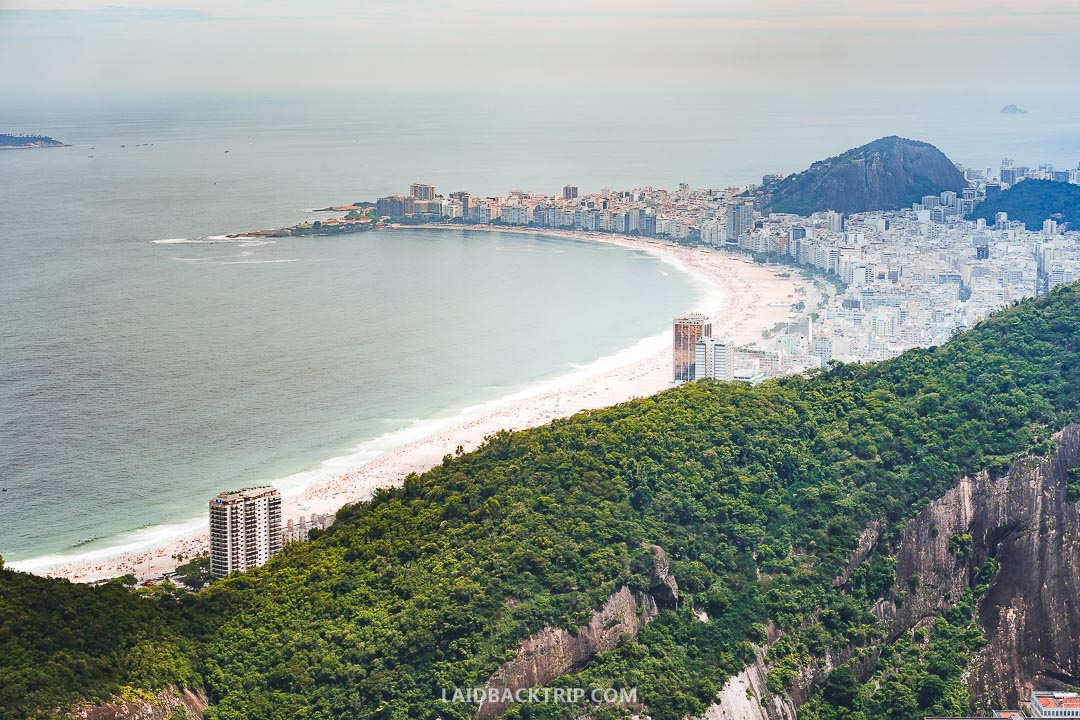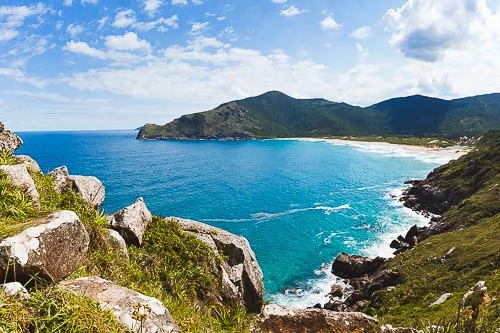3 Days in Rio De Janeiro
We spent three days in Rio de Janeiro and put together our ultimate guide on the best things to do, top attractions, where to stay and how to stay safe while visiting the city.
While traveling in Brazil, we couldn't miss Rio de Janeiro, a city set in a beautiful landscape, a city with unmistakable atmosphere and controversial reputation.
We must admit that even though we had traveled around South America for eight months and could consider ourselves experienced travelers we had serious concerns before visiting Rio de Janeiro.
While reading all those experiences of other travelers, it almost seemed that no one leaves Rio de Janeiro without being robbed or mugged, and although we had seen some incredible photographs of the city and are aware that people usually share online negative experiences than positive ones, we did not feel any desire to visit it at first.
Being in the colonial town Paraty, only several hours drive away from Rio we knew we would have regretted skipping this ultimate tourist destination later.
Especially when we already visited some places with a bad reputation before, for example, the capital city of Ecuador, Quito or Bogota in Colombia.
So it happened that we arrived in Rio de Janeiro for three full days and now we can bring you our guide on the best things to do in the city in 72 hours.
SAFETY IN RIO DE JANEIRO
But let's have a closer look at safety in Rio de Janeiro.
First, do not let paranoia ruin your stay, but there are several steps you can do not to be an easy target (although there are still situations you cannot have fully under control).
The biggest problem in Rio is petty theft such as pickpocketing - keep your valuables safe, it is advised to walk around only with the necessary amount of cash, also do not show off your electronics.
Most of the crime is drug-related, so do not visit favelas (only on tour) and overall suburbs - when driving, always check your GPS that it doesn't guide you through dangerous zones.
We recommend you not to walk on the streets after dark, rather take Uber - that's what we did all the time here, and it paid off.
Also, it is better to wander around the city center from Monday to Saturday. On Sundays, the Centro is deserted, and you would be more vulnerable.
We also wrote the whole post about safety in South America with tips and advice on how to stay safe when traveling, hope you will find it useful.
THINGS TO DO IN RIO DE JANEIRO
Now, after visiting Rio de Janeiro, we can say it aloud.
We've never seen a city set in a more beautiful landscape yet.
Green hills, beaches, sparkling sea, and Christ the Redeemer overlooking it all are exactly the reasons why people are driven to visit Rio de Janeiro.
The good news is that it is not hard to visit it all in only three days!
Getting lost in colorful streets of Rio de Janeiro has never been easier.
SUGARLOAF MOUNTAIN
One of the hills surrounding Rio de Janeiro stands out in particular among others.
It is the iconic Pão de Açúcar alias Sugarloaf mountain, a 396 meters high peak which got its name because of the resemblance to the shape of a concentrated refined loaf of sugar.
During our travels in South America, we noticed a slight obsession with sugar in every country - not only everything is too sweet, but there is not a region without a hill named Sugarloaf.
But we are not afraid to say this one is the most famous one.
The monolithic granite rising straight from the water reminded us the most Piedra del Penol (it will always remain a mystery to us why just this one doesn't carry the sugar-related name), a large rock near Medellin.
Sugarloaf Mountain is a spectacular sight even when you admire it from a distance, but when you reach the summit, you will be rewarded with a truly breathtaking panorama which is hard to beat.
We arrived at the parking lot close to the cable car to Sugarloaf mountain with Uber, but you can also take an irregular bus from Copacabana, 511 and 512.
Here is also a small, but cute beach Praia Vermelha where you can chill before or after conquering the Sugarloaf Mountain.
The area around the hill is safe because it is close to police and military station and lots of locals come here to spend their time actively.
It is impossible to reach the top without taking a cable car, but you can decide whether you will use two rides from the ground station to Morro da Urca and then from Morro da Urca to the top of Sugarloaf Mountain (for R79) or only one ride from Morro da Urca to Sugarloaf Mountain (for R59).
We decided to hike the first section, in order to save some cash, which goes through the forest where we could see many monkeys.
It is not a long neither difficult hike and should take you around 30, quite sweaty minutes to say at least.
When we arrived in the first viewing platform on Urca Hill (you can buy cable car tickets here as well) where travelers must change cable cars, we hesitated for a while if it is worth it to reach the top as the view from here was already pretty awesome, but it really gets even better up there!
The best time to visit Sugarloaf Mountain and avoid crowds is early in the morning or late in the afternoon to catch the sunset.
The place is in its busiest from 10 AM to 3 PM, during this period there's a high chance you will wait for the cable car for 30 minutes or more.
CHRIST THE REDEEMER
In the world, there are hardly a handful of iconic attractions so closely connected to the destination.
Christ the Redeemer is one of them.
Even people who have never thought of visiting Brazil know the statue overlooking the bay and guarding the city and can correctly place that the statue is in Rio de Janeiro.
I think we won't be exaggerating when claiming that the statue of Christ the Redeemer is not only as a symbol of Rio de Janeiro but also a symbol of Brazil in many people's minds.
Standing on the top of Corcovado Mountain, the statue became the must-visit spot while in Rio, not only for the Christ itself but chiefly because of the views from the top, comparable to those you can get when on Sugarloaf Mountain.
The place has been lately receiving immense popularity and it means only one thing for visitors - long queues.
Here we have a tip you should follow - book your ticket for an exact time slot in advance on the official website, so you will avoid lines.
Because weather affects the visit of Christ the Redeemer a lot (it is often foggy and hazy), we booked ticket only a few hours before our visit when we checked the weather forecast.
Luckily, there were still spots available despite high season.
We absolutely recommend booking your train tickets in advance. When we were coming back from the top, the first time slot available for those without tickets was in three hours.
There are three ways how to reach Christ the Redeemer.
The cheapest and most adventurous is hiking to the top through Tijuca Forest National Park, but we advise you not to do it because many robberies and assaults have been reported in the past.
Unless you are hiking in a large group, we wouldn't take our chances as the budget trip can easily turn into the most expensive one.
Another way is to reach the top by bus - the official bus to the statue starts in the middle of the hill, so you need to get there by taxi.
It means switching ways of transport, and the price is almost similar to taking the train, so we think the best way is to take the legendary cog train to the top.
It is the safest mean of transport plus great experience.
LAPA DISTRICT
Lapa is a district right next to the Centro and is well-known for two attractions.
Arcos de Lapa, a monumental aqueduct and for Escadaria Selaron, colorful steps which happen to be one of those must spots where you need to take a photo when in Rio.
The tile-made steps are work of the Chilean-born artist Jorge Selaron who wanted to create a tribute to people of Brazil by using the colors of the Brazilian flag.
Nowadays, those steep steps include tiles from Brazil but also from other parts of the world, and the result is truly magnificent and vibrant.
The busiest is the lower part of steps where everyone wants to take pictures with Rio de Janeiro sign - there is even a queue where we refused to wait - but higher you climb the more crowd disperse.
When traveling by public transport, take a metro to Gloria Station, exit the station and walk north along Rua da Gloria which becomes Rua da Lapa.
When you get to Rua Teotonio Regadas, carry on to the left, and it will lead you to Selaron steps.
CITY CENTER
When visiting Lapa and Selaron steps, you can get to the city center on foot and quickly find out that Rio is not only a city set in a beautiful landscape, but it also has lots to offer when it comes to architecture.
The historic center of Rio de Janeiro is worth to walk around, although the new buildings almost everywhere outgrew the traditional houses and you must dig deeper to discover the old city's face in today's financial center.
There are churches, colonial buildings or notable places such as theater or bank, so walk around with your eyes wide open.
Do not forget you are still in Rio though and always be aware of your surroundings.
COPACABANA & IPANEMA BEACH
Before arriving in Rio de Janeiro, we had read a lot of articles about Copacabana Beach, not positive ones, and felt quite reluctant to visit it.
At first, we even wanted to skip it and go only to the neighboring Ipanema Beach, but explorers inside us did not let us.
For many, Copacabana Beach is a symbol of danger, robbing and tons of plastic waste, but for us, it was just a regular strip of white sand surrounded by luxurious hotels.
Overall, we are not fans of city beaches, but thanks to its length, we were happy to stretch our legs.
When it comes to safety, we recommend you to keep an eye on your belongings (one of you should always stay with bags).
But we did not notice anything suspicious, and we were not harassed by sellers either, but it might be because we were only walking on the beach and did not lay down at all.
Based on reviews, we expected Copacabana to be dirty and covered by plastic, but it was not an issue either.
Once we heard that if you would come to Copacabana looking for trash, it will be there.
If you would come with realistic expectations, you will enjoy it like any other city beach.
Generally, nowadays tourists and locals prefer Ipanema Beach, another perfect sandy strip only 10 minutes walk from Copacabana.
For us, it looked very similar, only the landscape was even more beautiful, and it felt more relaxed.
And what can you do on both beaches? Sunbath, swim, jog, play football or drink a caipirinha!
Travel Insurance
We never leave home without travel insurance that was designed to cover our expenses if something goes wrong during the trip.
Travel insurance protects against theft, flight delays, injury, illness, cancellations, and much more.
World Nomads provides travel insurance for travelers to cover their trip essentials, including sports and adventure activities.
SafetyWing is affordable travel insurance for backpackers, long-term travelers, and digital nomads.
Travel smarter and safer!
MUSEUMS
Although most of all people are preoccupied with visiting Christ the Redeemer, Sugarloaf Mountain or Escadaria Selaron, the truth is that Rio de Janeiro has some interesting museums as well.
Even when you do not intend to visit either Museo de Arte do Rio, or Museu do Amanha alias Museum of Tomorrow, you should not miss the latter one as the futuristic building is pretty impressive.
Standing next to the waterfront at Pier Maua this construction was opened in 2015, and since then it is one of the architectural treats of Rio.
PORT
Rio de Janeiro is a busy tourist destination where the capacity of hotels is often insufficient
The reality is that lots of travelers don't even sleep in the city as large ships arrive every day carrying thousands of one-day visitors who disembark in the port, trying to get as much as possible from the city and return in the evening to set off to a new destination.
To have a better idea, head to the main port, to observe enormous ships leaving Rio de Janeiro usually around 5 PM.
These ships are without exaggerating cities within cities, and although it is not the way of travel we would prefer, there is something captivating on watching these floating giants to leave the port.
ETNIAS
Etnias or Ethnicities in English is the name of our favorite street art in South America.
The fifteen meters high and 170 meters long wall depicts five faces of indigenous people from five different regions of the world.
It is worth mentioning that the painting was done by one person, Eduardo Kobra, who created this mural for the Olympic Games taking place in 2016 in Rio de Janeiro.
It is no coincidence that there are five faces as it is an analogy for five Olympic rings. The mural is vibrantly colorful, and well-worth your time.
You can find the work on the Olympic Boulevard of Rio de Janeiro, opposite the entrance to the port and close to the Museum of Tomorrow.
WHERE TO STAY IN RIO DE JANEIRO
There is no shortage of accommodation in Rio, but it can be booked out long in advance during busy periods such as Carnival or Eastern.
When looking for a hotel, always check the reputation of the area first.
There are two major areas where visitors usually stay - near the city center or close to two famous beaches.
Budget | Hotel Belas Artes - It will probably be hard to find a room with breakfast close to the city center for a similarly cheap price, so when available, go for it.
Mid-range | Ibis Rio de Janeiro Santos Dumont - A classic modern chain hotel where you know what to expect. It is in a safe area, and the service is excellent.
Luxury | Miramar Hotel by Windsor - Amazing hotel located right across Copacabana Beach is a top choice for everyone looking for a high standard and perfect settings.
Alternatively, search for your accommodation via Hostelworld.
HOW TO GET AROUND RIO DE JANEIRO
Rio de Janeiro has an extensive system of public transport.
The most reliable is the metro, so it is a good idea to stay near a metro station.
You can also use buses, but the system seems a bit confusing for first-timers, or there are also two tram lines which go frequently and you can use them for example when you need to get from the bus terminal to the city center.
To use public transport, you need to purchase a plastic rechargeable card for R5 (you can get it at the tram station or in the metro).
We used all three types of transport, but when we needed to get to one of the most famous landmarks like Sugar Loaf Mountain, Copacabana or Christ the Redeemer, we always used Uber.
It's safe, fast, and relatively cheap.
Another very popular way how to get around Rio is renting a bike from one of many stands (you need to register online) spread out throughout the city.
HOW TO GET TO RIO DE JANEIRO
As you might guess, Rio is well-connected with almost all destinations within Brazil by bus, and for sure with all tourist destinations such as Iguazu Falls, Florianopolis, Sao Paulo or Paraty.
Rio de Janeiro has a domestic and international airport.
There are also many rental car companies in the city.
WHAT TO PACK FOR RIO DE JANEIRO
It's really hot in Rio de Janeiro in general, and you will need a good sunscreen, comfy shoes and plenty of water.
Comfortable Shoes for Him & for Her | Wear a comfy shoes for exploring Rio de Janeiro.
Backpack for Him & for Her | Take a comfortable backpack to fit there snack, water, extra layers of clothes and umbrella.
Umbrella | In case it rains, bring along an umbrella.
Sunscreen | We used SPF 50+ every day in Brazil.
Camera | A small and light travel camera is perfect for photographing Rio de Janeiro.
You can also check out our South America packing list, if you're planning on traveling around this beautiful continent.
Travel Resources
Here you can find links to all the travel resources we use and which you might find helpful when planning your next holiday.
Accommodation: When looking for accommodation, we usually search hotels via Booking.com or Hostelworld.
Tours: Although we love to travel independently, some places are better to visit with a guided tour.
We prefer GetYourGuide for its easy-to-use interface and solid reputation. Another great alternative is Viator.
Rental Cars: When going on a road trip, we always use Rentalcars.com, a reliable site for booking a rental car in advance.
Flight Tickets: When looking for flight tickets, you can search Skyscanner to find the best price.
Travel Insurance: World Nomads and SafetyWing cover against risks of travel.






















